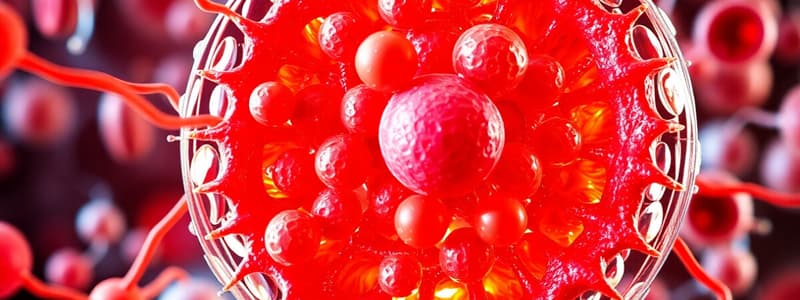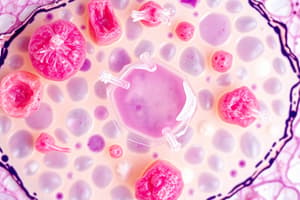Podcast
Questions and Answers
Which of the following cell types is primarily involved in photosynthesis?
Which of the following cell types is primarily involved in photosynthesis?
- Neutrophils
- Sperm Cells
- Palisade Mesophyll Cells (correct)
- Red Blood Cells
Gram-negative bacteria have a thick peptidoglycan layer.
Gram-negative bacteria have a thick peptidoglycan layer.
False (B)
What is the primary function of root hair cells?
What is the primary function of root hair cells?
Absorption of water and nutrients
The ________ is a group of organs working together to perform specific physiological functions.
The ________ is a group of organs working together to perform specific physiological functions.
Match the cell types with their specialized functions:
Match the cell types with their specialized functions:
Which of the following statements is true regarding eukaryotic cells?
Which of the following statements is true regarding eukaryotic cells?
The plasma membrane is present in both prokaryotic and eukaryotic cells.
The plasma membrane is present in both prokaryotic and eukaryotic cells.
Bacterial cells accumulate in clusters called ________.
Bacterial cells accumulate in clusters called ________.
What is the main function of goblet cells in columnar epithelium?
What is the main function of goblet cells in columnar epithelium?
Endothelial tissue is important for regulating blood flow and pressure.
Endothelial tissue is important for regulating blood flow and pressure.
What is the process by which plaques form in the arteries, and what cells are primarily involved?
What is the process by which plaques form in the arteries, and what cells are primarily involved?
The sliding filament theory involves the interaction of __________ and __________ filaments.
The sliding filament theory involves the interaction of __________ and __________ filaments.
Match the following types of muscle fibers with their characteristics:
Match the following types of muscle fibers with their characteristics:
What is the resting membrane potential of myelinated neurons?
What is the resting membrane potential of myelinated neurons?
Saltatory conduction slows down the speed of nerve impulse transmission.
Saltatory conduction slows down the speed of nerve impulse transmission.
What are the two main types of neurons based on the presence of myelin sheath?
What are the two main types of neurons based on the presence of myelin sheath?
Flashcards
Cell Theory
Cell Theory
All living things are made of cells, the basic units of life.
Cell Differentiation
Cell Differentiation
Specialized cells develop from stem cells to have unique tasks.
Gram-Positive Bacteria
Gram-Positive Bacteria
Bacteria with thick peptidoglycan cell walls, sensitive to penicillin.
Gram-Negative Bacteria
Gram-Negative Bacteria
Signup and view all the flashcards
Palisade Mesophyll Cells
Palisade Mesophyll Cells
Signup and view all the flashcards
Sperm Cell Function
Sperm Cell Function
Signup and view all the flashcards
Red Blood Cell Structure
Red Blood Cell Structure
Signup and view all the flashcards
Squamous Epithelium
Squamous Epithelium
Signup and view all the flashcards
Goblet Cells
Goblet Cells
Signup and view all the flashcards
Cilia
Cilia
Signup and view all the flashcards
Endothelial Tissue
Endothelial Tissue
Signup and view all the flashcards
Atherosclerosis
Atherosclerosis
Signup and view all the flashcards
Sarcomere
Sarcomere
Signup and view all the flashcards
Sliding Filament Theory
Sliding Filament Theory
Signup and view all the flashcards
Myelin Sheath
Myelin Sheath
Signup and view all the flashcards
Nodes of Ranvier
Nodes of Ranvier
Signup and view all the flashcards
Study Notes
Cell Theory and Structure
- All living organisms are composed of cells, the fundamental units of structure, function, and organization.
- Differentiation is the specialization of cells from stem cells for specific functions.
Tissues, Organs, and Systems
- Tissues are groups of similar cells performing specific functions (e.g., epithelial, muscle, nervous).
- Organs are collections of tissues performing specific physiological functions (e.g., heart, lungs).
- Organ systems are groups of organs working together (e.g., cardiovascular, respiratory).
Prokaryotic and Eukaryotic Cells
- Prokaryotes (bacteria): Nucleoid, plasmids, 70S ribosomes, capsule, cell wall.
- Eukaryotes (animal): Plasma membrane, cytoplasm, nucleus, endoplasmic reticulum (smooth & rough), Golgi apparatus, vesicles, lysosomes, 80S ribosomes, mitochondria, centriole.
- Eukaryotes (plant): All animal components plus chloroplasts, vacuole, tonoplast, amyloplasts, cell wall, plasmodesmata.
Microscopy and Gram Staining
- Electron micrographs and light microscopes visualize cell organelles.
- Gram staining differentiates bacteria based on cell wall structure.
- Gram-positive: Thick peptidoglycan layer, sensitive to penicillin.
- Gram-negative: Thin peptidoglycan layer, outer lipopolysaccharide membrane, less sensitive to penicillin.
Specialized Animal Cells
- Palisade mesophyll cells: Cylindrical shape, chloroplasts for photosynthesis, large vacuole.
- Sperm cells: Nucleus with 23 chromosomes, acrosome, mitochondria, tail.
- Egg cells: Nucleus with 23 chromosomes, large cytoplasm, zona pellucida.
- Root hair cells: Large surface area for absorption, mitochondria, thin walls.
- White blood cells (WBCs):
- Lymphocytes (T & B cells): Immunological memory, antibody production, destroy infected cells.
- Neutrophils: Phagocytic, mobile.
- Red blood cells: Biconcave shape for large surface area, no nucleus, flexible for oxygen transport.
- Squamous epithelium: Lines alveoli, thin for rapid diffusion, e.g. in lungs
- Columnar epithelium (with goblet cells): Ciliated, goblet cells secrete mucus; cilia move mucus (trachea).
- Endothelial tissue: Single layer of squamous cells lining blood vessels; reduces friction, regulates blood flow, allows nutrient and waste exchange in capillaries; Damaged endothelium contributes to atherosclerosis.
COPD and Epithelial Tissues
- COPD damage to alveoli reduces surface area and breathing.
- Endothelium is essential for smooth blood flow.
Measuring and Calculating Cell Size
- Use ocular (eyepiece) graticule and stage micrometer to measure cells in micrometers.
- Calculate magnification using the formula: Magnification = Image size / Actual size.
Skeletal Muscle Tissue
- Muscle fibers are multinucleated and striated, composed of repeating sarcomeres.
- Contains Sarcolemma, sarcoplasmic reticulum, mitochondria.
- Sliding filament theory describes muscle contraction, involving actin and myosin filaments sliding past each other.
- Fast-twitch fibers contract quickly but fatigue rapidly, relying on anaerobic metabolism.
- Slow-twitch fibers contract slowly and are fatigue-resistant, utilizing aerobic metabolism.
Myelinated Neurons and Nerve Impulse Conduction
- Myelinated neurons have myelin sheaths speeding up impulse conduction.
- Non-myelinated neurons conduct impulses slower.
- Nerve impulse conduction (action potential) involves resting membrane potential, depolarization, threshold, repolarization, and saltatory conduction (jumping between nodes of Ranvier).
Atherosclerosis
- Atherosclerosis is the build-up of plaques in artery walls.
- White blood cells (foam cells) accumulating, narrowing the lumen (interior space) of arteries.
- Plaque rupture can cause blood clots (thrombus) leading to cardiovascular problems.
Studying That Suits You
Use AI to generate personalized quizzes and flashcards to suit your learning preferences.
Description
Test your knowledge on cell theory, the structure of prokaryotic and eukaryotic cells, and the organization of tissues, organs, and systems. This quiz covers essential concepts about how living organisms are composed of cells and how these cells specialize for various functions. Dive in to learn more about the building blocks of life!




